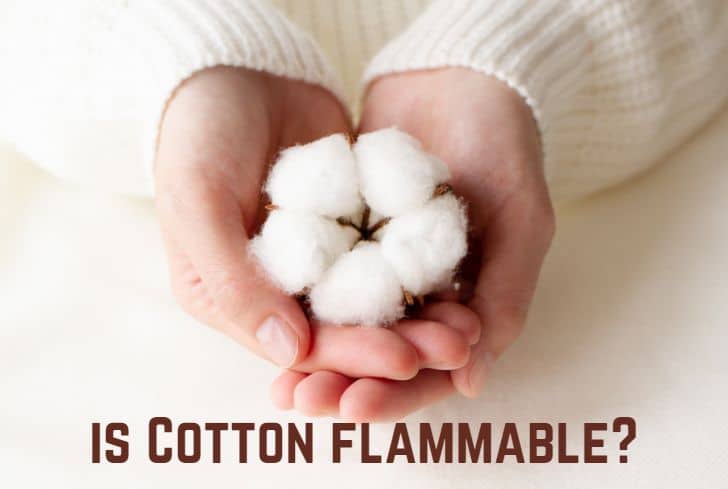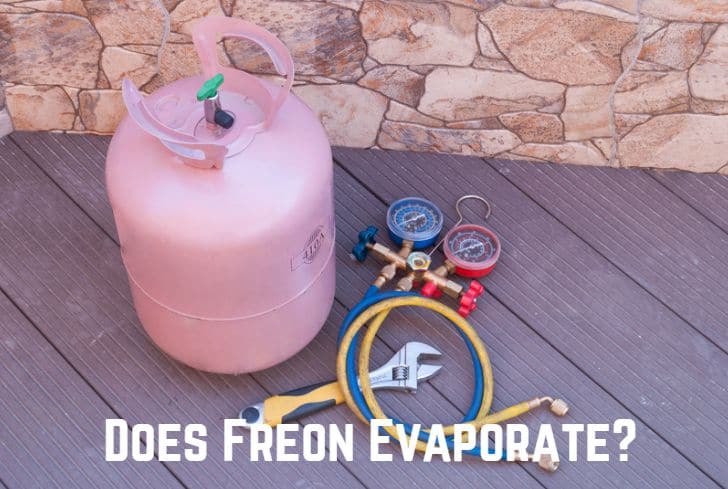Is Cotton Flammable? (Answered)

You are heading to a party wearing your lovely cotton dress or shirt. There will be some fireworks at the party. But just before you walk out the door, you remember a friend mentioning that cotton burns easily. You’re wondering if you ought to go back and change. Is cotton flammable, though?
The article explains cotton’s flammability, how quickly it burns, why it is such a flammable material, and the temperature at which it burns. Additionally, we inform you whether burning cotton is toxic and whether cotton candy is flammable. Finally, you’ll learn whether cotton is environmentally harmful and can be fire-resistant.
Read: Is Glue Flammable?
Is Cotton Flammable?
One of the most flammable materials available is cotton. It is also a low-quality fabric with little resistance to fire. Cotton is a plant that is extremely flammable and sensitive to fire. It can produce heat and is made of combustible cellulose fibers. The combustion of hydrogen and carbon enables the generation of heat from cellulose.
You can observe how quickly paper burns since it contains cellulose. The same holds for cotton. Cotton is not self-extinguishing. Thus, it will burn until you put it out. Cotton becomes easily flammable when placed near another object already on fire or close to a direct flame. When cotton ignites, it burns up quite quickly.
Does Cotton Burn Easily?
Cotton burns so quickly that it is not advised to dry cotton clothes in an electric dryer. Cotton clothing has been known to burn quickly when exposed to strong fire or electric heat from a fire. It’s easy for a tumble drier to reach the autoignition point of cotton and set it on fire.
Here is a short demonstration of how you can identify cotton by burning it:
Plant-based fabrics like cotton and linen rapidly catch fire and burn. The smell of burning cotton is similar to that of burning paper, leaves, or wood. The residual substance will be flaky, blackened ash. Compared to burning cotton, linen will burn less brightly and paler ash.
Why Is Cotton Such a Flammable Material?
Cotton is highly flammable due to several reasons. The fact that cotton possesses cellulose fibers, like wood and leaves, stands out the most. Cotton can retain heat because it is a natural plant-based material. It is made of thick cellulose fibers that fuel burning. High temperatures will cause cotton to start melting and burning.
Pyrolysis is the process through which cotton melts and burns when exposed to high heat. Cotton burns to produce water vapor and carbon dioxide. The smoke that results from pyrolysis has a plastic or burnt rubber odor.
Cotton is flammable compared to other materials because its fibers burn at lower temperatures. It also doesn’t have as many air pockets as those other fibers. Fewer air pockets make it easier for cotton fibers to ignite and burn faster.
Cotton contains other flammable substances besides cellulose. Wax and fats are some of cotton’s additional components. Cotton is made significantly more flammable by these components.
At What Temperature Does Cotton Burn?
Compared to other materials like linen, cotton burns at a relatively low temperature of 410°F (210°C). Cotton will burn at such temperatures when it interacts with substances like super glue. Chemicals in the adhesive, like cyanoacrylate, react with the cotton fabric to start a fire. Thus, when temperatures hit 764°F(407°C), cotton is more likely to self-ignite.
When the temperature reaches 410°F (210°C), cotton begins to decompose and produce heat. The cotton fire will keep burning as long as there is a constant supply of oxygen.
Is Cotton Candy Flammable?
Cotton candy is not flammable. When cotton candy is set on fire, it crystallizes. The candy is not made from cotton, which happens to be flammable. The candy is light and fluffy and resembles cotton wool. To create sugar threads, you must spin the sugar and heat it to high degrees.
The candy’s name comes from the fibrous threads resembling cotton threads. Apart from the name, cotton candy has different characteristics from cotton. The cotton candy will melt a little when a flame is applied before the fire extinguishes. The flames will need to be lit multiple times.
Cotton candy crystallizes when thrown into a fire that is already blazing. Since we know that sugar is not flammable, the sugar in the candy crystallizes. If you try boiling cotton candy in a pan, it will turn greenish-brown. The color change signifies a chemical occurrence that proves that cotton candy is made from different chemicals.
Read: Is Lysol Flammable?
How Fast Does Cotton Burn?
Cotton will burn in as little as 20 minutes to two hours if it lacks fire-retardant qualities. Cotton that is wet or has fire-retardant qualities will burn more slowly. In wet cotton, water works as a fire suppressor. You can burn your cotton in less than ten seconds if you have high-temperature flame sources.
An ordinary match or lighter will take a bit longer to burn cotton. The speed of burning depends on the size of the cotton you want to burn. The source of the flame will also be significant. A bigger flame will burn your cotton more quickly. It will take a little longer to burn a large cotton cloth.
Is Cotton Toxic When It Burns?
If you are burning 100% cotton, it will not release toxins. However, cotton might emit harmful compounds if it contains other substances. Cotton that has been colored or modified is likely to release certain toxins. However, cotton fabrics that have been combined with or added flame-retardant chemicals are the most toxic.
While 100% cotton might not produce toxins inhaling its smoke is also quite risky. Lung damage and respiratory issues might result from breathing cotton smoke.
Can We Make Cotton Fire Resistant?
Yes, it is possible to make cotton fire-resistant. Historically, cotton was most frequently treated with formaldehyde to make it fire-resistant. Cotton, however, becomes difficult to wear due to the chemical. Triphenylphosphine oxide is now added in place of formaldehyde to make cotton fire-resistant. The substance reacts with its two monomers to create a physical network in the cellulose.
One of the monomers is a nitrogen-containing component, and the other is a phosphorous-containing component. Inside the cellulose fibers of the cotton, the network creates a physical and chemical fire retardant. In this manner, the cotton fabric can maintain its positive qualities while remaining fire-resistant.
A small team of researchers from Jilin University in China has identified another approach to making cotton fire-resistant. They recommended using ammonium polyphosphate, which is also a flame retardant. The cotton is also treated with a binding agent called polyethyleneimine. Finally, they make cotton hydrophobic by adding ethanol and the cage-like molecule silsesquioxane.
Is Cotton Harmful to the Environment?
Natural fibers like cotton are considered to be more environmentally friendly. However, regrettably, that is not the case. The growing of polyester is more environmentally friendly when compared to cotton. While cotton fibers break into soil nutrients, polyester can be biodegraded. Below are a few more explanations for why cotton is considered environmentally harmful.
Consumes a Lot of Water
Water is vital for the growth of cotton. In most cotton-growing regions, rainwater is not enough for cultivation. Cotton farmers are forced to seek alternatives, and in most situations, they draw water from water bodies like rivers and lakes.
Other agricultural uses, as well as people and animals, suffer when these water sources direct the water to cotton cultivation.
Soil Degradation
Cotton requires a lot of space to grow properly, and intercropping is typically not an option. Large areas will need to be converted for cotton growing. Soil salinization occurs when cotton is grown with a lot of water. It becomes difficult for other plants to grow in salinized soil.
Long-term cotton cultivation in some places has exhausted the soil in such areas, pushing farmers to look for another land. Due to the need to clear huge expanses of land, deforestation and the loss of wildlife habitat have become concerns in most places.
Because cotton is the only crop you can cultivate, there isn’t enough tree cover to protect the land, which causes topsoil erosion.
Chemical Use
Cotton farmers use a lot of synthetic fertilizers and pesticides to boost productivity and manage pests in their cotton crops. Pesticides and fertilizers are frequently used, harming the environment over time. They contain toxic substances that harm people, animals, and marine life.
One of the crops with the highest pesticide consumption worldwide is cotton, which uses 4.7% of the world’s pesticides. Tribufos, glyphosate, and diuron are pesticides cotton producers use that have been linked to human cancer. They also lead to neurological conditions and issues with reproduction, such as infertility, congenital disabilities, and miscarriages.
Additionally, by contaminating drinking water, these substances increase greenhouse gas emissions.
Pollution During Cotton Production
Most individuals are ignorant of the environmental costs of wearing lovely cotton clothing. Chemical processing, dyeing, and breaching are major causes of industrial water contamination. When cotton is processed, water that contains chemicals, hazardous colors, chlorine, and pesticides is left over.
Lakes, rivers, and underground water bodies frequently become home to the pollutants listed above.
Read: Is Wool Flammable?
Conclusion
Cotton burns quickly and is highly flammable. It is more flammable due to elements like its wax and fat content and cellulose fibers, which burn at low temperatures. Compared to other materials, cotton burns at 410°F (210°C), a relatively low temperature.
Triphenylphosphine oxide and ammonium polyphosphate are two chemicals for making cotton fire-resistant. Both act as fire retardants and make cotton resistant to fire. It is crucial to remember that cotton, particularly its production and growth, is considered harmful to the environment. Thus, caution must be exercised.






